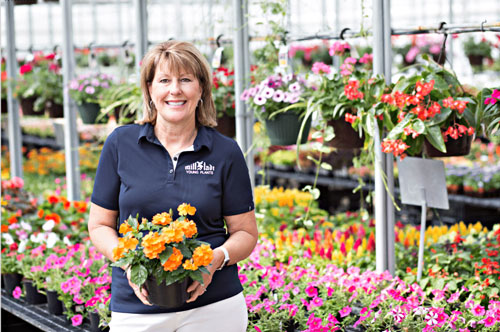10/1/2018
Fifty Shades of Red
Amy Morris

Editor’s note: We’re pleased to welcome Amy to our contributing writing staff—she’s the first woman in our Growers Talk Business rotation. We’re excited to see what pro insights she’ll be sharing with you!—JZ
Color. An innocuous word that leads to so many questions in our business when it comes to plants. Do we have the right hue? Do we have enough selection? Or are we driving our growers crazy with all the small blocks of the same plant, but in slightly different hues? At what point do we have too much color? At what point do we not have enough? And, perhaps most importantly, do our customers even know the difference?
Before we go any further, what is color, anyway? Merriam-Webster defines color as: “The property possessed by an object of producing different sensations on the eye as a result of the way the object reflects or emits light.” Seems simple enough, right? Not exactly.
With the upcoming poinsettia season, I thought the concept of colors would be fun to talk about. “Fifty Shades of Red”—catchy title, but I guess I should correct myself and say it should be “100+ Shades of Red!” In our unique industry, we’re spoiled for color choices, but how do we determine what colors are selling and worth growing?
It starts with breeders. They work their tails off to find the best color, size, branching and disease-resistant plants. Always searching for the deepest color or the brightest color to catch the eye of the consumer. Does our consumer see the different shades or do they just see red? It seems that we get caught in a vortex when it comes to color. What starts out as an array of color diminishes into handful of basic colors delivered to our customer.
Our sales force works with retailers to make sure that each market has its own unique look and brand by making sure every color is represented. The growers want to grow what they’re comfortable with. To them, their dream is full-house runs of the same item. They hope sales orders are big enough that it doesn’t cause striping on their floors and force different micro-groups to manage. All of these forces work together to present the consumer with a variety of colors to choose from.
We have the privilege to host one of North America’s largest poinsettia trial here at Millstadt. To me, it’s Christmas in November! I get so excited when all the breeding companies, brokers, retailers and fellow growers come down to our event. It’s a week of experiences to work with the breeders and find out what their vision is for their new numbered varieties. It’s a great chance to see what they’re comparing and competing against when breeding. Getting to work with the brokers to see what they’re selling and why they feel certain plants are good for their customer is a great opportunity to get their input on what’s trending for the season.
It’s a great week of comradery and respect between all branches of the business. On the Sunday before Thanksgiving, we open our door to the public. Last year, we had over 4,000 in attendance. Not only do we get to see friend and family alike, we get to educate the public on how many different shades of colors are available.
I can’t tell you how many times I’ve heard people say, “I thought poinsettias only came in red!” It’s our pleasure to show them that not only do they come in red, but just how many shades of red and other colors there are. Our guests are always amazed by the variety of colors at our greenhouse and often leave with carts full of rainbow and a newfound possibility of colors available that’ll keep them coming back for more. That’s just good business.
It’s our job to educate the end consumer. There’s a full spectrum of colors to introduce to our customers through our product. Our industry has come a long way in terms of giving customers brand-new experiences. By working together, our industry can illuminate these shades to our consumers and give them choices for their homes they never thought possible. To me, that’s one of greatest parts of the job. After all, what’s the point of growing all these beautiful colors if customers can’t enjoy them? GT
Amy Morris is Vice President of N.G. Heimos Greenhouses in Millstadt, Illinois.